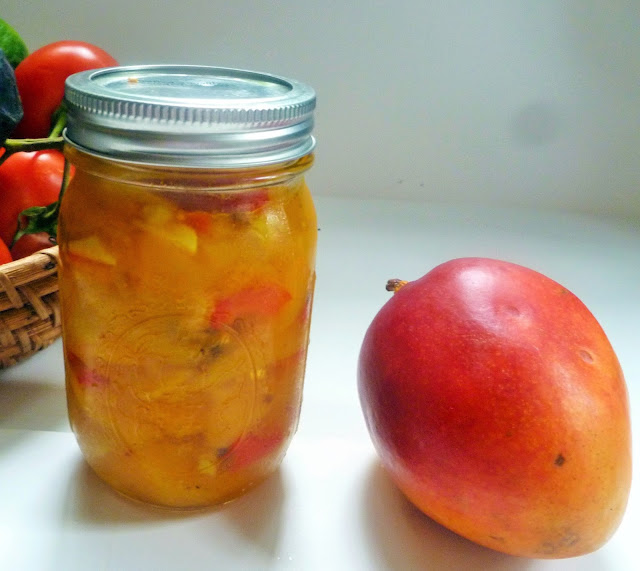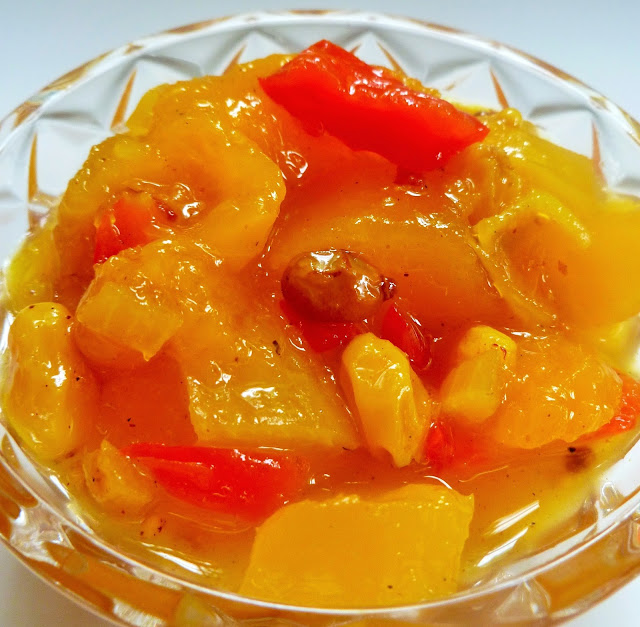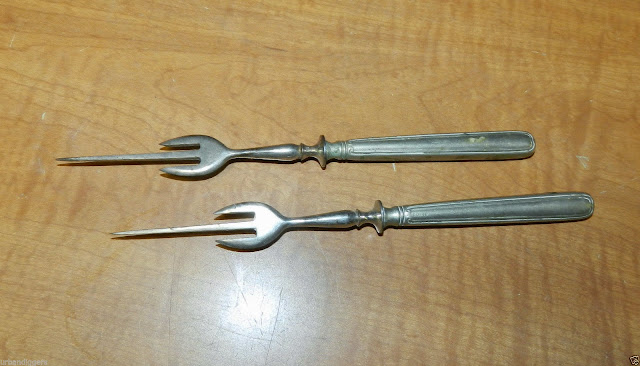Like a lot of you who have been exposed to mango chutney in this country or in the UK, I grew up on Major Grey's. I don't know if it is the best chutney in the world but it is definitely my benchmark and what I pull out of the fridge to accompany Indian food and sometimes grilled meats. I know, sacrilege. I should probably be shot by the chutney police but some habits are hard to break.
I have made chutney before and, in mid summer, my Georgia Peach Chutney is a staple in this house. I have also had the real stuff in my travels, sometimes so hot I couldn't breathe; but I had never tackled mango chutney at home until yesterday. A few months ago, my friend Chronica Domus asked me for a recipe, specifically for mango chutney. I never forget a request, but I was waiting for mango season to make a batch for the house and close friends I don't know if you have noticed that the mangoes this year are outstanding. It must have also been a bumper crop, for I got 10 for $10. How could I pass that.
Madame Mere and I adore mango marmalade with cream cheese and crackers, something we both grew up with in Cuba. If you really want to savor a mango, though, you must have one on the beach, knee deep in water, with the waves breaking on your legs, a mango in one hand and a mango fork or a knife in the other. I will never forget the time one of my childhood friends showed up with a set of sterling mango forks and a bag of mangoes to enjoy on the beach in Key Biscayne.
If you are very lucky, you will have inherited a sterling set of mango forks from your great grandmother. The last time I remember seeing one before that memorable day at the beach was at my grandmother's house in Havana. I wonder who is using them now and what they are using them for!
After making a batch of marmalade for MM, I remembered CD's request and went back for more mangoes. I wanted to make a homemade version of my adored Major Grey's. I also did not want one of those cloudy chutneys where you don't know what is what. I wanted to see the pieces of mango and I wanted them crystal clear. It had to be sweet, but not too sweet and hot but not oppressive. I could have stopped with the mustard seeds, and you can too, but I also wanted some spice. Luckily, when it comes to Asian spices, I have a good supply, so the only thing I had to buy was the caramelized ginger. I like the texture it gives my peach chutney. In the end, I think I ended up with what, in my mind, is a homemade version of Major Grey's, keeping in mind that commercial versions of chutney are never going to come close to one made at home.
Now, if you are wondering what the mango fork has to do with making mango chutney, it was the thought of that memorable day on the beach, sharing a mango with two childhood friends. Priceless!
Mango Chutney
Chutney is a family of condiments associated with South Asian cuisine made from a highly variable mixture of spices, vegetables, or fruit. There is a wide variety of recipes and preparation methods depending on geography. Chutney can also range from wet to dry, and from sweet or hot.
The original chutney of India was usually a relish made from fresh fruits and spices. During the colonial era the British took it home and the recipe evolved, until the commercially made mango chutney ("Major Grey's chutney") became the British standard chutney. Commercially made cooked chutneys are still popular in Great Britain, and are usually made of fruit (usually mangoes, apples or pears), onions and raisins simmered with vinegar, brown sugar and spices for about two hours. Chutneys are served with almost every meal in India, especially as relishes with curries, but also as sauces for hot dishes (especially meats). They can be fresh or cooked, and are made from a wide variety of ingredients, ranging in flavor from sweet or sour, spicy or mild, or any combination; they can be thin or chunky and can be made with fruits or vegetables or both. Mangoes, apples, pears, tamarind, onions, lemon, tomato, raisins, coconut, vinegar, sugar, honey, citrus peel, garlic, ginger, mint, turmeric, cinnamon, cilantro, and hot chilies are some of the ingredients used. Cooked mango or papaya chutneys are common in the Caribbean and have become increasingly popular in the United States. Food.com
Lindaraxa' Sweet And Spicy Mango Chutney*
Yield 3 pints and 1 cup
Ingredients:
5-6 mangoes (5 cups) peeled and diced
2 cups of white granulated sugar
1 cup white vinegar
1 onion chopped
1 red pepper diced
1/2 cup golden raisins
1/4 cup crystalized ginger finely chopped
2 garlic cloves, mashed and minced
1 tsp. whole mustard seeds
1 tsp coriander seeds
3 kaffir lime leaves
1/4 tsp turmeric
1/2 tsp whole cloves
1/4 tsp cinnamon
1/4 tsp ground cardamon
1 tsp salt
1/2 tsp. red pepper flakes
Directions:
Combine the sugar and the vinegar in a large pot, bring to a boil, reduce to medium high and stir until fully dissolved.
Add the mangoes, onion, red peppers, raisins, ginger and garlic and mix around in the pot. Let them simmer in the syrup while you mix the spices.
Combine the rest of the ingredients (the spices) in a bowl or other container and add to the pot.
Simmer, uncovered and stirring occasionally, for 45 minutes to 1 hour, or until syrupy and slightly thickened.
Remove the kaffir leaves and spoon into clean jars leaving 1/2 inch head space. Close jars and process in water bath 15-20 minutes.
*If you want your chutney less "crystal clear", substitute brown sugar for the white sugar.
If you want it "mushier" cook longer. Otherwise, I would not mess with the spices, it's perfect.
Try Georgia Peach Chutney With Caramelized Ginger
Grilled Chicken Tikka With Fresh Mango Chutney







































.JPG)




















